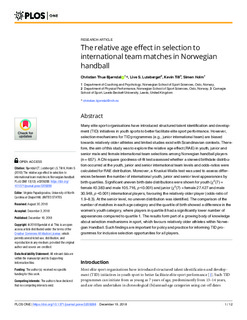| dc.contributor.author | Bjørndal, Christian Thue | |
| dc.contributor.author | Luteberget, Live | |
| dc.contributor.author | Till, Kevin | |
| dc.contributor.author | Holm, Simen | |
| dc.date.accessioned | 2019-04-25T07:39:11Z | |
| dc.date.available | 2019-04-25T07:39:11Z | |
| dc.date.created | 2019-03-05T11:07:03Z | |
| dc.date.issued | 2018 | |
| dc.identifier.citation | PLoS ONE. 2018, 13, e0209288. | nb_NO |
| dc.identifier.issn | 1932-6203 | |
| dc.identifier.uri | http://hdl.handle.net/11250/2595371 | |
| dc.description | This is an open access article distributed under the terms of the Creative Commons Attribution License, which permits unrestricted use, distribution, and reproduction in any medium, provided the original author and source are credited. | nb_NO |
| dc.description.abstract | Many elite sport organisations have introduced structured talent identification and development (TID) initiatives in youth sports to better facilitate elite sport performance. However, selection mechanisms for TID programmes (e.g., junior international team) are biased towards relatively older athletes and limited studies exist with Scandinavian contexts. Therefore, the aim of this study was to explore the relative age effect (RAE) in youth, junior and senior male and female international team selections among Norwegian handball players (n = 657). A Chi-square goodness-of-fit test assessed whether a skewed birthdate distribution occurred at the youth, junior and senior international team levels and odds-ratios were calculated for RAE distribution. Moreover, a Kruskal-Wallis test was used to assess differences between the number of international youth, junior and senior level appearances by birth quartiles. Significant uneven birth date distributions were shown for youth (χ2(7) = female 40.383 and male 105.716, p <0.001) and junior (χ2(7) = female 27.427 and male 30.948, p <0.001) international players, favouring the relatively older player (odds-ratio of 1.9–8.3). At the senior level, no uneven distribution was identified. The comparison of the number of matches in each age category and the quartile of birth showed a difference in the women’s youth category, where players in quartile 8 had a significantly lower number of appearances compared to quartile 1. The results form part of a growing body of knowledge about selection mechanisms in sport, which favours relatively older athletes within Norwegian Handball. Such findings are important for policy and practice for informing TID programmes for inclusive selection opportunities for all players. | nb_NO |
| dc.language.iso | eng | nb_NO |
| dc.subject | sports | nb_NO |
| dc.subject | Norwegian people | nb_NO |
| dc.subject | Norway | nb_NO |
| dc.subject | statistical distributions | nb_NO |
| dc.subject | human performance | nb_NO |
| dc.subject | careers | nb_NO |
| dc.subject | Europe | nb_NO |
| dc.subject | games | nb_NO |
| dc.title | The relative age effect in selection to international team matches in Norwegian handball | nb_NO |
| dc.type | Journal article | nb_NO |
| dc.type | Peer reviewed | nb_NO |
| dc.description.version | publishedVersion | nb_NO |
| dc.rights.holder | © 2018 Bjørndal et al. | nb_NO |
| dc.source.pagenumber | 12 | nb_NO |
| dc.source.volume | 13 | nb_NO |
| dc.source.journal | PLoS ONE | nb_NO |
| dc.source.issue | 12 | nb_NO |
| dc.identifier.doi | 10.1371/journal.pone.0209288 | |
| dc.identifier.cristin | 1682315 | |
| dc.description.localcode | Seksjon for coaching og psykologi / Department of Coaching and Psychology | nb_NO |
| cristin.unitcode | 150,32,0,0 | |
| cristin.unitcode | 150,31,0,0 | |
| cristin.unitname | Seksjon for coaching og psykologi | |
| cristin.unitname | Seksjon for fysisk prestasjonsevne | |
| cristin.ispublished | true | |
| cristin.fulltext | original | |
| cristin.qualitycode | 1 | |
